If you’re starting an online business, understanding what a warranty disclaimer is is one of the first things you need to learn to protect it.
A warranty disclaimer is essentially a statement in a written contract that specifies the limitations of a seller’s liability for the product or service provided. It clarifies that you, the seller, will not be held liable for any damages that may arise post-purchase.
Why is this important? Well, it protects your business from unexpected claims by setting clear expectations and helps customers understand exactly what they are buying.
To help make sure it does what it’s supposed to, we’ll talk about the different types, who needs it and why, and what to include when crafting a warranty disclaimer.
- You need a warranty disclaimer to protect your business. It limits your liability for any issues with your products or services.
- Clearly define what your warranty covers and doesn’t cover. Be specific about exclusions and limitations.
- Consult a lawyer to ensure your warranty disclaimer complies with all legal requirements and effectively protects your business.
Table of Contents
PRO TIP: Take the hassle of writing your own disclaimer away with our disclaimer generator trusted by over 200,000 businesses. It’ll save you hours of work and possible costly legal mistakes.
Types of Warranty Disclaimers
Knowing the purpose and distinctions of the different types of warranty disclaimers is key to effectively managing customer expectations and minimizing legal risks.
Here’s a breakdown of the most common types used in eCommerce:
Express Warranty Disclaimer
An Express Warranty Disclaimer clarifies that the only guarantees provided about a product or service are those explicitly stated in the terms of sale. It limits the seller’s liability to only what is directly promised in the marketing materials or sales contract.
This means that descriptions, representations, or promotions must be carefully worded to avoid implying additional guarantees you are not willing to uphold.
Basically, since you and your customers have the same understanding of what is being promised, this prevents potential disputes over unmet expectations.
Take a look at this Express Warranty Disclaimer clause from Angi:
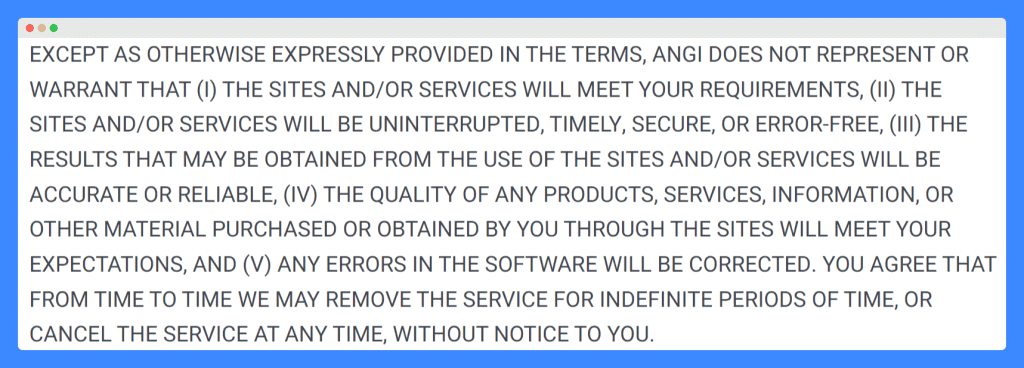
This part of their Terms of Use agreement outlines what Angi does not guarantee regarding the performance and reliability of its services. By saying except as expressly set forth in the terms, they effectively delineate the bounds of their commitment.
PRO TIP: Be mindful of your product descriptions and marketing materials. Any claim you make can be considered an express warranty.
Implied Warranty Disclaimer
Unlike Express Warranties, which are explicit promises about a product, Implied Warranties are assumptions made by customers about the product’s quality or suitability.
For instance, when you buy a pair of shoes, you automatically assume they won’t fall apart after a single wear. An Implied Warranty Disclaimer is a legal statement that removes this assumption.
It specifically disclaims all implied warranties of merchantability and fitness for a particular purpose. Essentially, it tells customers that you’re not promising anything beyond what’s explicitly stated in your contract or product description.
Even if you haven’t explicitly made any promises, customers still have expectations. An Implied Warranty Disclaimer helps clarify that you’re not responsible for these unspoken assumptions.
As Is Warranty Disclaimer
An “As Is” disclaimer explicitly states that the goods are sold “as is,” which means the seller provides no warranties regarding the quality, condition, or functionality of the products.
This type of disclaimer essentially notifies buyers that they are taking full responsibility for the product once the purchase is completed. They also cannot hold the seller liable for any issues that arise post-purchase.
It can also refer to a visitor’s use of the site, like in Dazzling Spaces’ website terms and conditions:
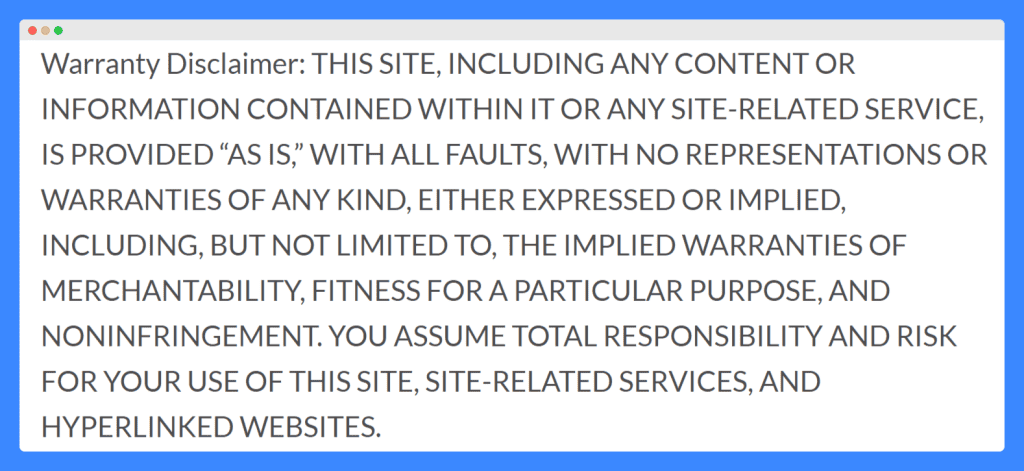
This broader application of the “As Is” disclaimer not only limits liability for physical products but extends to the digital environment of the website itself. This ensures users acknowledge the inherent risks associated with using the site and its services.
Merchantability Disclaimer
A Merchantability Disclaimer is used by online businesses to specifically disclaim any implicit warranty that the goods being sold are fit for the general purpose for which they are intended.
This type of disclaimer states that the seller does not guarantee that the products meet the standards of quality and performance that are generally expected, including any warranty of merchantability or fitness for any particular purpose.
It helps protect sellers by clarifying that the products are sold without these assurances, which might otherwise be implied by law.
PRO TIP: To minimize risk and for transparency, write detailed product descriptions and specifications. This ensures customers are informed about the product’s limitations before making a purchase.
Fitness for a Particular Purpose Disclaimer
A Fitness for a Particular Purpose Disclaimer removes the implied warranty that your product is suitable for a specific use.
Unlike a merchantability disclaimer, which focuses on general product quality, this disclaimer specifically addresses the product’s ability to meet a customer’s particular needs.
For example, if you sell hiking boots and a customer specifically asks if they are suitable for high-altitude climbing, you might disclaim the implied warranty of fitness for a particular purpose (hiking in high altitudes).
This means you are not guaranteeing that the boots will perform as expected in those extreme conditions.
General Warranty Disclaimer
A General Warranty Disclaimer is a broad statement used by online businesses to explicitly declare that the seller makes no warranties or representations about the products or services offered beyond those specifically stated in the terms of sale.
This type of disclaimer is comprehensive, covering a wide range of potential warranty claims that could arise, and it is not limited to any specific aspect of the product or service.
That said, while a general warranty disclaimer offers maximum protection, it’s crucial to use it judiciously.
PRO TIP: Overly broad disclaimers might be challenged in court. Combine a general disclaimer with more specific ones to provide a balanced approach.
Limited Warranty Disclaimer
A Limited Warranty Disclaimer outlines specific limitations to the warranties you offer. Instead of completely disclaiming all warranties, you’re setting clear boundaries for your liability.
For example, you might offer a limited warranty for product defects but exclude damages caused by misuse.
This type of disclaimer is often used to balance customer satisfaction with risk management. By providing a limited warranty, you can build trust with customers while protecting your business from excessive claims.
Here’s an example of this type of warranty disclaimer from KitchenAid:

By outlining the repair process and geographical limitations, KitchenAid ensures customers understand the extent of their warranty coverage. The specification of the warranty’s effective date also provides clarity on when the protection begins.
Who Needs a Warranty Disclaimer?
Virtually all businesses involved in a contract for the sale of goods and services need a warranty disclaimer to clarify what is not covered by any express or implied kind of warranty.
With a warranty disclaimer, businesses can protect themselves from consequential damages and ensure clients do not expect products or services to be error-free.
Here are some of the most common businesses and industries that need it:
Product Sellers
Product sellers use warranty disclaimers to specify that no express or implied warranties apply unless explicitly stated. This is essential to manage consumer expectations and to limit liability for product failures.
Software as a Service (SaaS)
SaaS providers must clearly state that their services are provided “as is” with no warranties that the software will be error-free or uninterrupted. This prevents assumptions of performance beyond the agreed terms.
Product Manufacturers
Manufacturers, including car manufacturers, typically issue limited warranties and disclaim all other warranties to shield against claims for defects not covered by the warranty. This ensures customers understand the extent of protection provided.
Legal Services
Law firms and solo practitioners include disclaimers in their communications to clarify that the information provided does not create an attorney-client relationship and that no warranty is given about the legal content being error-free.
Why Do You Need a Warranty Disclaimer for Your Website?
You need a warranty disclaimer for your website because it clarifies that there is no representation or warranty of any kind whatsoever implied unless explicitly stated.
This helps protect you from liability for claims that could arise due to misconceptions about your products or services.
Here’s a more detailed look at the reasons why you need one:
- It Limits Legal Liability: Explicitly stating the warranties set forth helps shield your business from legal liability in cases where customers might assume broader coverage or guarantees than you intend to provide.
- It Clarifies Product and Service Expectations: A clear disclaimer ensures customers understand what to expect, reducing misunderstandings and potential legal disputes.
- It Enhances Customer Trust: Transparent communication about what your warranty covers and what it excludes can build trust by setting realistic expectations.
- It Helps Meet Legal Standards: Implementing a warranty disclaimer can help ensure compliance with local and international trade laws, which might require such disclosures to prevent deceptive practices.
8 Key Components of a Warranty Disclaimer
A well-structured warranty disclaimer not only clarifies the scope of support and liabilities for your products or services but also sets the right legal expectations.
Here are the essential components that should be included in any warranty disclaimer to ensure it meets legal standards while protecting both your business and your customers:
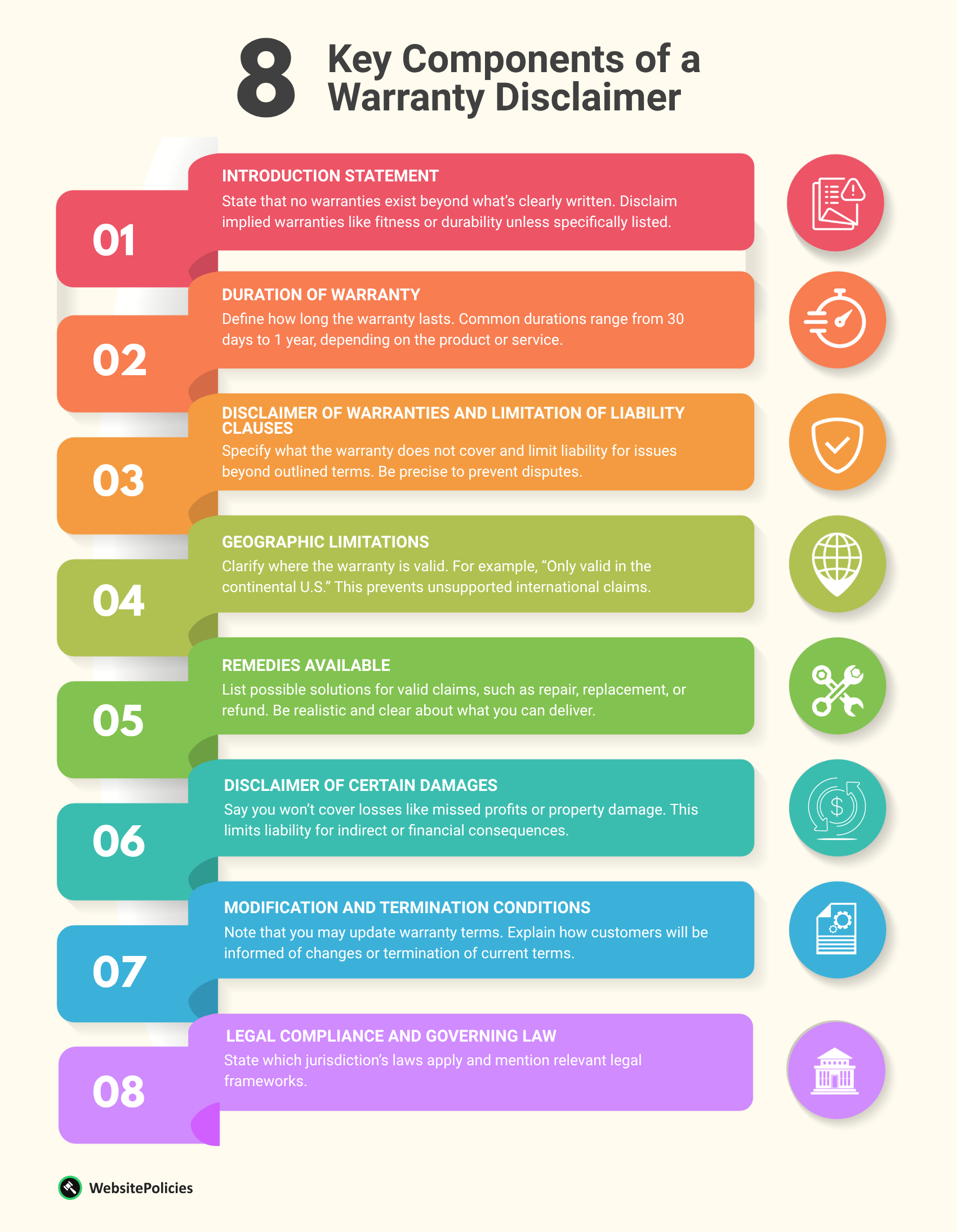
1. Introduction Statement
The introduction statement sets the stage by explaining that the business makes no representations or warranties about the product or service beyond what is explicitly stated.
This component communicates to customers that the business does not provide any additional guarantees, including without limitation, to the quality, durability, or fitness of the goods.
It may further state that the business neither impliedly warrants that the goods are suitable for any particular purpose nor provides any statutory or implied warranties unless specifically mentioned.
PRO TIP: Avoid making the introduction statement overly complex or legalistic. Use clear and concise language that is easy for customers to understand.
2. Duration of Warranty
This part specifies the time frame during which the warranty is valid and enforceable. It informs customers about the period within which they can seek remedies, such as repairs or replacements if the product fails to meet the stated specifications.
Typically, the duration of a warranty is fairly standard across the board, ranging from 30 days to a year, depending on the type of product or service offered.
3. Disclaimer of Warranties and Limitation of Liability Clauses
The Exclusions and Limitations section specifies the conditions, situations, or types of damages that are not covered under the warranty.
It often includes limitation of liability clauses that restrict the extent of the business’s responsibility for any issues that might arise, thereby protecting the company from unforeseen legal claims.
By specifying what is excluded, your business hereby disclaims all warranties beyond what is outlined. It also addresses representations and warranties arising from assumptions beyond the warranties expressly set forth in this agreement.
PRO TIP: Be thorough and precise when outlining exclusions and limitations to minimize ambiguity. Regularly review these clauses to ensure they reflect your current business practices and products.
4. Geographic Limitations
Different regions might have varying legal requirements, costs, and logistics involved in fulfilling warranty claims, so specifying geographic limitations helps businesses manage these factors effectively.
For instance, if you’re an online retailer based in the United States, you might specify that the warranty is only valid within the continental United States. This helps manage expectations and prevents customers from expecting warranty service in countries where you don’t have a presence.
Aside from avoiding misunderstandings with customers who might assume that a warranty applies universally, it also helps businesses plan for support and service logistics in regions where they can efficiently provide warranty coverage.
5. Remedies Available
This section outlines the specific actions you will take to address warranty claims. So, clearly state the remedies available to customers, such as repair, replacement, or refund.
For example, you could say:
“The sole and exclusive remedy for any breach of this warranty is the repair or replacement of the defective product, as provided in this agreement. Seller shall not be liable for any incidental or consequential damages, except for the express warranties provided herein.”
PRO TIP: Avoid making promises you can’t keep. Consider the potential cost and logistical challenges of each remedy before including it in your warranty disclaimer.
6. Disclaimer of Certain Damages
A Disclaimer of Certain Damages specifically outlines the types of damages for which you, as the business owner, will not be held responsible.
It’s different from Exclusions and Limitations, which generally list specific conditions under which the warranty does not apply, such as wear and tear, misuse, or damage from external sources.
Instead, it goes a step further by specifying the financial consequences of a warranty breach, such as lost profits or damages to other property.
The disclaimer of warranties clause often includes language stating that the business is not liable for any damages that result from the use of the product beyond what has been specified in the warranty terms.
The Disclaimer of Certain Damages applies regardless of any course of dealing or usage of trade that might imply broader coverage.
7. Modification and Termination Conditions
This section gives the business the flexibility to adapt the warranty terms in response to changes in law, business practices, or product offerings. It also clarifies that the terms at the time of purchase are not necessarily fixed and can be updated.
This is especially relevant in rapidly changing industries where product updates and improvements are frequent. This part is where you specify how customers will be notified of any changes or terminations.
8. Legal Compliance and Governing Law
This part specifies the legal framework and jurisdiction that govern the interpretation and enforcement of the warranty terms.
It defines which laws apply to the warranty and where any disputes related to the warranty must be resolved. Some laws that online business owners should be aware of include:
- Magnuson-Moss Warranty Act: This federal law governs warranties on consumer products costing more than $15. It stipulates certain requirements for warranties to ensure that they are not deceptive or unfair.
- Uniform Commercial Code (UCC): The UCC provides guidelines on commercial transactions. Its provisions can influence how warranty disclaimers are structured and enforced.
- State-Specific Consumer Protection Laws: Each state may have its own laws that affect warranty disclaimers, especially regarding the limitation of implied warranties and the ability of a business to exclude or modify certain warranties.
Incorporating a clause like, “This warranty shall be governed by and construed in accordance with the laws of the State of [State], without regard to its conflict of laws rules” helps ensure clarity about the governing laws.
PRO TIP: Consult with legal counsel to ensure your warranty disclaimer is compliant with both federal and state laws.
How Do You Write a Warranty Disclaimer for Your Business?
This is a general guide, and the specific requirements for your warranty disclaimer may vary. But here’s how you can create a solid and legally compliant warranty disclaimer:
Step 1: Consult with an Attorney
Before you start writing your warranty disclaimer, seek legal advice from an attorney experienced in business law. They can provide guidance on the specific legal requirements for your industry and location.
Step 2: Identify Your Product or Service
Clearly define the product or service you’re offering. This will help you determine the appropriate scope of your warranty and the specific risks you need to address.
Step 3: Determine Warranty Coverage
Decide what you will and won’t cover under your warranty. Consider factors such as product lifespan, potential defects, and customer expectations.
Step 4: Include All Essential Components
Ensure your warranty disclaimer includes all the key components discussed earlier.
A warranty disclaimer template can serve as a starting point for your document. It provides a basic structure and includes warranty disclaimer sample clauses that you can adapt to your specific needs.
Step 5: Review and Revise
Carefully review your warranty disclaimer to ensure it’s clear, concise, and legally sound. Make necessary revisions to improve readability and effectiveness.
Where to Display a Warranty Disclaimer on Your Website
Display your warranty disclaimer prominently where it should be easily accessible. The goal is to make sure users understand the terms of purchase before they buy anything.
To do this, strategically place your warranty disclaimer in:
- General Terms and Conditions Agreement: This is the most common location for a warranty disclaimer. It’s where customers typically find the terms governing their relationship with your business.
- Dedicated Warranty Page: For more complex warranties, a separate page specifically outlining warranty terms can be beneficial.
- Product Pages: Displaying a brief warranty summary on product pages can provide customers with quick information.
- Checkout Process: Including a link to the warranty disclaimer during checkout can serve as a final reminder.
- Website Footer: Placing a link to your warranty disclaimer in the website footer ensures easy accessibility for users.
Warranty Disclaimer Examples You Can Learn From
Exploring how other companies craft their warranty disclaimers can offer valuable insights into creating an effective and legally sound disclaimer.
Here are a few examples from various industries that highlight different approaches and clauses:
Adored Vintage
Through its warranty disclaimer, Adored Vintage legally protects itself against potential claims related to product quality or performance by stating:

This example of warranty disclaimer clearly states that all items are provided “as is” and disclaims all implied warranties.
By making clear that the store does not guarantee the merchandise beyond the descriptions provided at the point of sale, Adored Vintage effectively manages customer expectations.
ZenDesk
Zendesk’s warranty disclaimer is a strong example of how SaaS companies can protect themselves from liability.
They explicitly state that their services are provided “as is” and “as available.” In turn, they effectively disclaim any implied warranties, such as merchantability or fitness for a particular purpose.
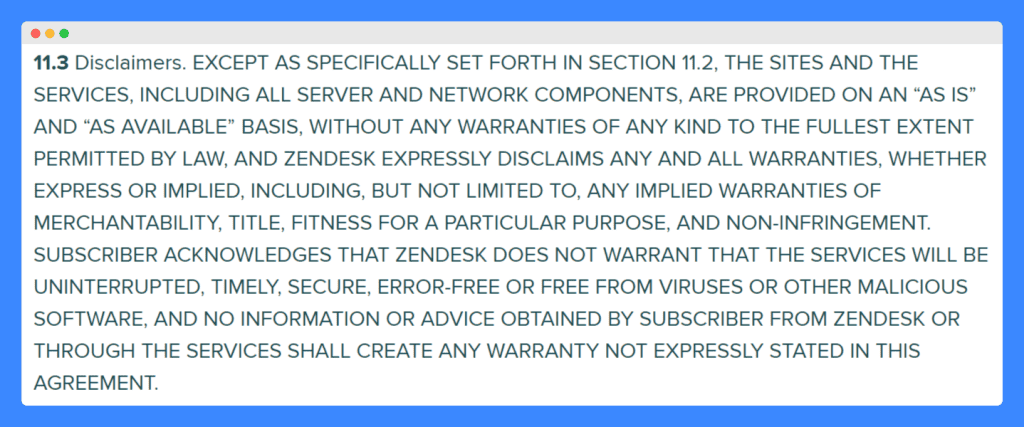
Additionally, their terms of service agreement outline that they do not guarantee uninterrupted or error-free service. This further protects them from potential claims related to service performance issues.
Apple
Apple’s warranty disclaimer is a prime example of how a product manufacturer can effectively protect itself while providing some level of warranty coverage.
By stating that the warranty provided is “exclusive and in lieu of all other warranties,” Apple effectively hereby disclaims all other warranties that might otherwise be implied.
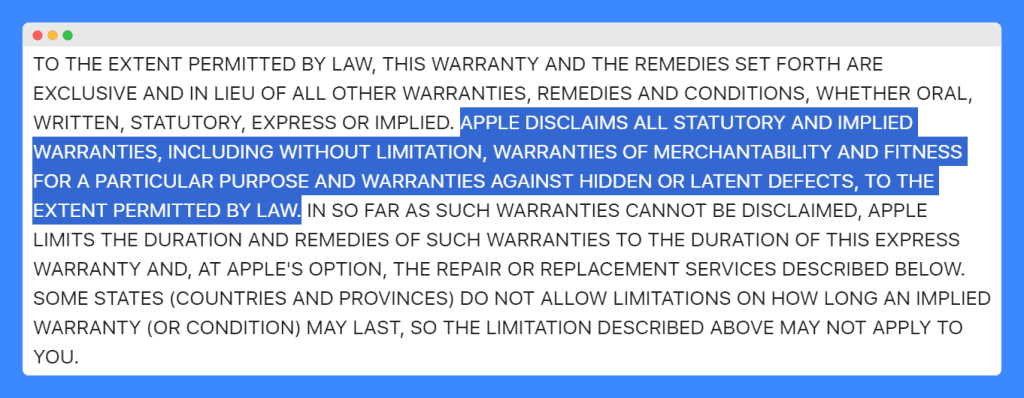
Additionally, their disclaimer explicitly mentions the disavowal of express and implied warranties, such as merchantability and fitness for a particular purpose, to the fullest extent permitted by law.
While Apple offers a limited warranty, it also acknowledges the legal limitations on warranty disclaimers and includes a provision for states or jurisdictions that do not allow such limitations. This demonstrates a balanced approach to warranty protection.
Open Hands
In its Terms and Conditions page, Open Hands has an excellent example of a warranty disclaimer for a legal services organization.

It clearly states that the content is offered “As Is” and that it makes no other warranties regarding its accuracy, reliability, or fitness for a particular purpose.
The disclaimer’s strength also lies in its detailed enumeration of what is not warranted.
Plus, it addresses the organization’s non-liability for damages incurred from using or not using the information provided. These include both direct and indirect impacts on business and data.
Warranty Disclaimer Template
This sample warranty disclaimer template serves as an introductory framework for drafting your own disclaimer for your website or blog. While it lays out the essential elements, it’s necessary to personalize and expand upon the content to address your unique situation and any specific legal considerations.
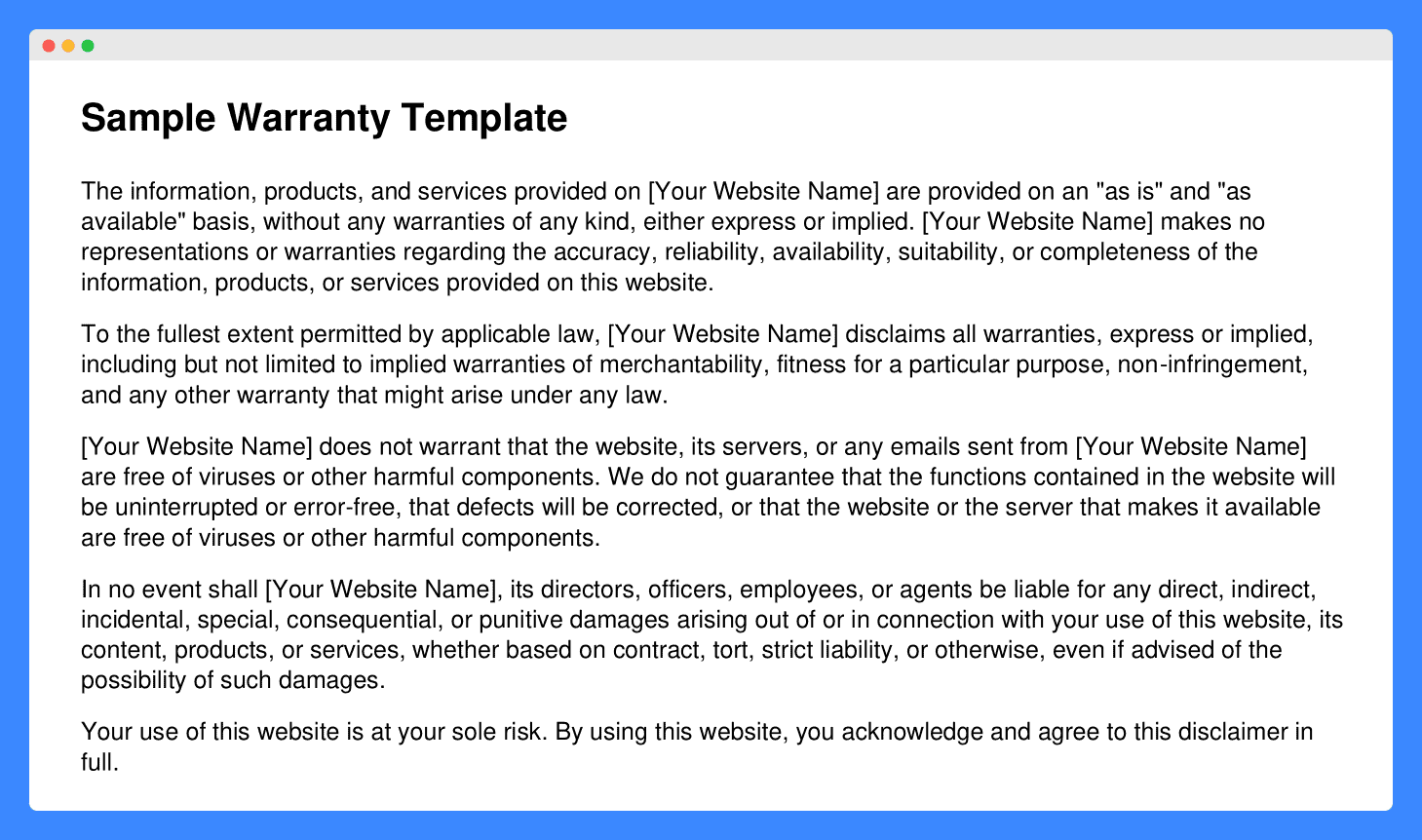
Frequently Asked Questions
How often should I review and update my warranty disclaimer?
Review and update your warranty disclaimer annually or whenever your products, services, or relevant laws change. Regular reviews help assess whether a disclaimer still effectively limits liability.
How do warranty disclaimers protect my business?
Warranty disclaimers protect your business by limiting legal liability. It does this by clarifying what is expressly disclaimed regarding product guarantees.
Can I use a standard warranty disclaimer for all my products?
A standard warranty disclaimer may not fit all products due to differences in use and risk with respect to the goods. Tailor disclaimers to specific product features and risks.
What common clauses should I include in my warranty disclaimer?
Include “as is” and limitation of liability clause samples in your warranty disclaimer. Tailor each to specific product risks and user expectations.
Why should I include an accuracy disclaimer in my warranty?
Include an accuracy disclaimer in your warranty to manage user expectations and limit liability for potential errors in product descriptions or functionality.
What does an “as is” warranty disclaimer cover?
An “as is” warranty disclaimer covers products without specific warranties or representations, indicating no guarantees on condition or quality.
When should I use a technical issues disclaimer?
Use a technical issues disclaimer when offering software or online services to manage expectations and limit liability for disruptions or failures.



